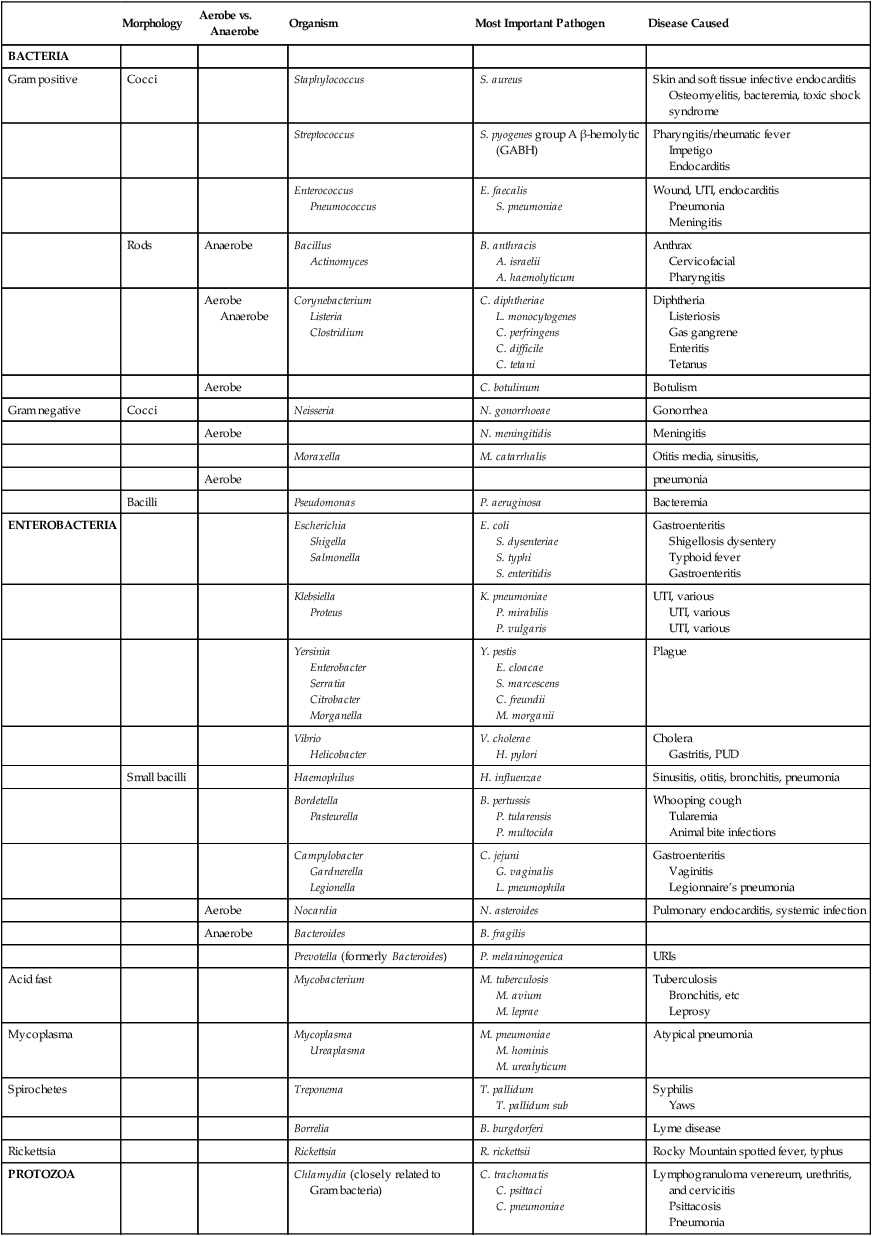Chapter 57 This chapter discusses general treatment principles applicable to most infections, with an emphasis on those of bacterial origin. Although these general guidelines cover the most common first-line primary care drugs, many exceptions are made to these recommendations. Remember to consider each patient with an infection as an individual case. Patterns of resistance change constantly and guidelines for treatment are updated at least yearly. Although these recommendations were the most current on publication, do not fail to consult the newest information from state and federal sources. The emphasis in this unit is on typical oral treatment for common primary care problems. The only exception is the use of single IM injections primarily for the treatment of sexually transmitted diseases. The first nine antiinfective chapters are focused on bacteria. Viruses and protozoa are discussed in Chapter 69; fungi are discussed in Chapter 67. The taxonomy of bacteria is undergoing changes that reflect the new body of information about the genetic components of bacteria. See Table 57-1 for information on bacteria that are important pathogens. Bacteria are one-cell organisms with a primitive nucleus and rigid cell walls that are porous and permeable to substances of low molecular weight. Gram-negative bacteria have a more complex cell wall than gram-positive bacteria. Bacteria are called gram negative or positive according to the results of laboratory Gram stains. The difference in their cell walls is an important factor in the ability of an antibiotic to penetrate the cell walls of bacteria and kill the bacteria. Another variable that is important in decision making is whether bacteria are aerobic or anaerobic (i.e., whether or not they need oxygen). This trait will determine where in the body the organism will grow best and potentially cause infection. This information is important when one is selecting appropriate antimicrobial therapy in the absence of culture results. TABLE 57-1
Principles for Prescribing Antiinfectives
Therapeutic Overview
Anatomy and Physiology
Morphology
Aerobe vs. Anaerobe
Organism
Most Important Pathogen
Disease Caused
BACTERIA
Gram positive
Cocci
Staphylococcus
S. aureus
Skin and soft tissue infective endocarditis
Osteomyelitis, bacteremia, toxic shock syndrome
Streptococcus
S. pyogenes group A β-hemolytic (GABH)
Pharyngitis/rheumatic fever
Impetigo
Endocarditis
Enterococcus
Pneumococcus
E. faecalis
S. pneumoniae
Wound, UTI, endocarditis
Pneumonia
Meningitis
Rods
Anaerobe
Bacillus
Actinomyces
B. anthracis
A. israelii
A. haemolyticum
Anthrax
Cervicofacial
Pharyngitis
Aerobe
Anaerobe
Corynebacterium
Listeria
Clostridium
C. diphtheriae
L. monocytogenes
C. perfringens
C. difficile
C. tetani
Diphtheria
Listeriosis
Gas gangrene
Enteritis
Tetanus
Aerobe
C. botulinum
Botulism
Gram negative
Cocci
Neisseria
N. gonorrhoeae
Gonorrhea
Aerobe
N. meningitidis
Meningitis
Moraxella
M. catarrhalis
Otitis media, sinusitis,
Aerobe
pneumonia
Bacilli
Pseudomonas
P. aeruginosa
Bacteremia
ENTEROBACTERIA
Escherichia
Shigella
Salmonella
E. coli
S. dysenteriae
S. typhi
S. enteritidis
Gastroenteritis
Shigellosis dysentery
Typhoid fever
Gastroenteritis
Klebsiella
Proteus
K. pneumoniae
P. mirabilis
P. vulgaris
UTI, various
UTI, various
UTI, various
Yersinia
Enterobacter
Serratia
Citrobacter
Morganella
Y. pestis
E. cloacae
S. marcescens
C. freundii
M. morganii
Plague
Vibrio
Helicobacter
V. cholerae
H. pylori
Cholera
Gastritis, PUD
Small bacilli
Haemophilus
H. influenzae
Sinusitis, otitis, bronchitis, pneumonia
Bordetella
Pasteurella
B. pertussis
P. tularensis
P. multocida
Whooping cough
Tularemia
Animal bite infections
Campylobacter
Gardnerella
Legionella
C. jejuni
G. vaginalis
L. pneumophila
Gastroenteritis
Vaginitis
Legionnaire’s pneumonia
Aerobe
Nocardia
N. asteroides
Pulmonary endocarditis, systemic infection
Anaerobe
Bacteroides
B. fragilis
Prevotella (formerly Bacteroides)
P. melaninogenica
URIs
Acid fast
Mycobacterium
M. tuberculosis
M. avium
M. leprae
Tuberculosis
Bronchitis, etc
Leprosy
Mycoplasma
Mycoplasma
Ureaplasma
M. pneumoniae
M. hominis
M. urealyticum
Atypical pneumonia
Spirochetes
Treponema
T. pallidum
T. pallidum sub
Syphilis
Yaws
Borrelia
B. burgdorferi
Lyme disease
Rickettsia
Rickettsia
R. rickettsii
Rocky Mountain spotted fever, typhus
PROTOZOA
Chlamydia (closely related to Gram bacteria)
C. trachomatis
C. psittaci
C. pneumoniae
Lymphogranuloma venereum, urethritis, and cervicitis
Psittacosis
Pneumonia
Flagellate
Trichomonas
Entamoeba
Cryptosporidium (spore forming)
Giardia (cyst forming)
Leishmania
Plasmodium
T. vaginalis
E. histolytica
C. parvum
G. lamblia
Many species
P. falciparum
P. vivax
P. malariae
P. ovale
Trichomonas vaginitis
Amebiasis colitis
Diarrhea
Diarrhea
Skin lesions
Malaria
Malaria
Malaria
Malaria
Toxoplasma
T. gondii
Toxoplasmosis
HELMINTHIC
Trematode
Cestode
Nematode
Schistosomiasis
Anisakiasis
Ascaris
A. lumbricoides
Ascariasis
Enterobiasis
Trichinella
T. spiralis
Trichinosis


![]()
Stay updated, free articles. Join our Telegram channel

Full access? Get Clinical Tree


Principles for Prescribing Antiinfectives
Only gold members can continue reading. Log In or Register to continue
